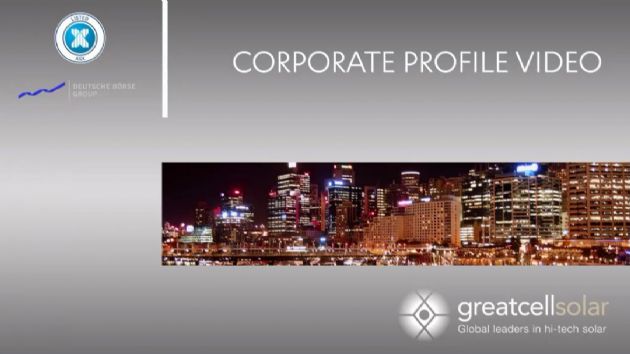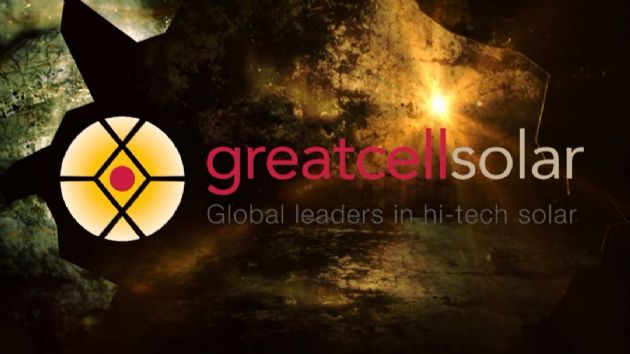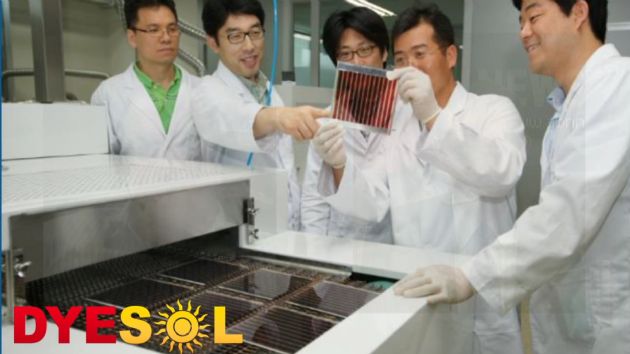 March 2017 Quarterly Report and Appendix 4C
March 2017 Quarterly Report and Appendix 4C
Canberra, April 28, 2017 AEST (ABN Newswire) - Dyesol Limited ( ASX:DYE) (
ASX:DYE) ( DYSOY:OTCMKTS) is pleased to provide the Company's latest Quarterly Activities Report for the period ending 31 March 2017.
DYSOY:OTCMKTS) is pleased to provide the Company's latest Quarterly Activities Report for the period ending 31 March 2017.
- Dyesol is Awarded a $2.5M Department of Industry CRC-Project Grant
- Technical Advisory Board Thermal Cycling Milestone Achieved for Glass Modules
- Technical Advisory Board Milestone for Metals Substrates Achieved
- Solliance/Dyesol achieve World Record of 12.6% Conversion Efficiency for Roll-to-Roll PSC
- Phase 2 of VDL ETG Major Area Demonstration Prototype Project Completed
Corporate and Financial
It was with considerable excitement and gratitude that Dyesol was awarded a Department of Industry CRC-Project grant of $2.5 million in February. This activity is led by Dyesol in collaboration with CSIRO and CSR Building Products and Dyesol is the major recipient ($1.9M) of the grant funds. The project is to develop advanced coatings expertise on large area glass substrates and will feed directly into our current scale-up activity associated with the Major Area Demonstration Prototype project.
The funding agreement has been signed and a participants agreement is expected to be signed with our collaboration partners in May following final corporate approvals. This is a truly inspiring partnership bringing together Dyesol's Perovskite Solar Cell (PSC) PV technology, CSIRO's extensive R&D facilities and CSR's glass manufacturing and supply chain capability. The potential for ongoing collaboration is considerable and brings this commercialisation opportunity to the boardrooms of critical players in building materials and energy.
Dyesol is in the advanced stages of discussion with state government(s) departments to determine what assistance may be available to support the establishment of the organisational structure and infrastructure required to build and operate a purpose built, dedicated prototyping facility. While a number of potential new sites have been identified, Melbourne and co-location is a lead candidate as it has access to excellent scientific resources, a strong manufacturing culture, and very good glass handling logistics and port facilities. We are looking at this from the perspective of future pilot line development and long-term mass manufacture.
During the quarter we have also made progress on other opportunities for significant federal government financial assistance, particularly in relation to technology diligence.
In the context of the ongoing funding of its activities, Dyesol is currently evaluating the best options to minimise shareholder dilution and maximise its commercial progress. Strategic investment opportunities exist from both local and international investors.
Research and Development
Dyesol conducted an international technology retreat in late March. This was a plenary style meeting bringing together key technology leaders in our global organisation. As such, we are enjoying the benefits of co-location and collaboration with the EPFL in Switzerland and Solliance in The Netherlands, in particular. We are now immersed heavily in prototype planning, preparation and manufacture, and it is essential to focus on technical risk management and device performance optimisation. At the meeting, the preferred technology candidate for commercialisation was confirmed.
Almost weekly, module performance is improving and recently several prospects for further improvement in conversion efficiency have been identified. This has immediate prospects, but also feeds into our Technology Development Plan. We are working closely with EPFL and Cristal on these work packages and are confident of publishing positive results shortly. Importantly, Dyesol's proprietary materials and processes are at the heart of these promising results and we expect to translate them to much larger devices.
With the benefit and assurance of external CSIRO validation, Dyesol has now passed its thermal cycling milestone for 10 x 10 cm modules. The module scale performance is the building block for larger devices. Better encapsulation and sealing have helped deliver this improved result. As a reminder, thermal cycling is part of the IEC 61646/61215 accreditation standard and involves 200 cycles of temperature variation between -40DEG C and +85DEG C in a strictly controlled test chamber. These tests were conducted both internally at Queanbeyan and at CSIRO in Newcastle and took approximately 7 weeks to complete. This is a tough, accelerated aging test and strongly endorses the stability of our industrially focused Porous Carbon (PC) architecture, our lead candidate for commercialisation. Importantly, the PC architecture has all inorganic charge transport materials and provides high durability. The IEC Outdoor Exposure test was also passed for glass modules during the quarter.
Concurrently, Dyesol Metals Group, operating out of Manchester, U.K. and Eindhoven, The Netherlands had a pleasing quarter. The Technical Advisory Board (TAB) milestone was to achieve a minimum conversion efficiency of 9% (Maximum Power Point Tracking) for all-inorganic PSC cells on metal substrates. This was comfortably achieved. Dyesol UK will now focus on stability tests to further substantiate the promise of this novel architecture, adapted for integration into flexible (opaque) substrates, notably polymers and metals. With IMEC at Solliance achieving 12.4% conversion efficiency on similar architectures in small modules there is every confidence of matching them shortly, albeit with a stability focus.
Solliance contributed handsomely to meeting other technical goals during the quarter also. In particular, it successfully demonstrated the manufacture of 12.6% PSC cells using automated roll-to-roll (R2R) processes. Such progress will help accelerate the commercialisation of the PSC technology and is unique and proprietary to Solliance and its consortium members. VDL Enabling Technology Group (ETG) was instrumental in building this pilot line and the demonstration provides strong confidence for metals based prototyping which is scheduled to begin in the second half of the calendar year. We continue to see enormous potential for building integrated photovoltaics (BIPV) on steel substrates. The underutilisation of rooftops in the industrial property sector is a very attractive opportunity.
Manufacturing and Collaborations
At Queanbeyan headquarters, where the focus is on glass substrate prototyping, we are working towards higher performing mini-MAD panels. Significant progress has been achieved on active area improvement with better scribing tools and techniques. The final mini-MAD 450 mm x 650 mm prototypes are due for completion at the end of June with translation into larger 600 mm x 1200 mm MAD panels considered to be a manageable step, especially for retention of underlying performance characteristics.
We have completed Phase 2 (Design and Engineering) of the VDL ETG Major Area Demonstration (MAD) project. All lead suppliers of tools for prototype manufacture and testing have been identified. Some tools are off-the-shelf, while others modified to meet more exacting specifications. For non-critical tools there has also been considerable cost savings identified by using alternative, cheaper Asian suppliers. Much of this information and costing has accompanied recent confidential submissions to government.
The April 16 Turkish Referendum has been welcomed by our commercialisation partners, Nesli. The referendum outcome should provide continuity and stability to this once strong and vibrant industrial economy. Subsequent to the referendum we are confirming financial commitments at all levels of government.
Elsewhere, there have been high levels of enquiry coming from Korea and China. We are seeing this most obviously in higher demand for PSC R&D grade materials from research institutions and universities. More importantly, though, it is apparent that the silicon panel manufacturers are becoming concerned with their slim profit margins and the rising threat of next generation technology. We were in China during late March at the invitation of the Chinese government and discussions are ongoing in relation to commercialisation opportunities there.
Financials
The net operating monthly cash burn (Sec. 1.9 of the Appendix 4C, see link below) for the third quarter averaged $988k. Net cash usage from operating and investing activities for the nine months to 31 March 2017 totalled $4.6m including the R&D rebate.
At the end of the third quarter, cash balances totalled $1.8m.
Since the end of the third quarter, Dyesol drew down $750k from its CBA finance facility that allows an advanced payment of accrued R&D tax offset credits. The Company also received the first payment of $442,000 from the CRC-P Project Agreement within the Department of Industry further increasing cash at bank.
To view the full Quarterly Report, please visit:
http://abnnewswire.net/lnk/0IR4819A
About Greatcell Solar Limited
 Greatcell Solar Limited (ASX:GSL) (OTCMKTS:DYSOY) is a global leader in the development and commercialisation of Perovskite Solar Cell (PSC) technology – 3rd Generation photovoltaic technology that can be applied to glass, metal, polymers or cement. Greatcell Solar Limited manufactures and supplies high performance materials and is focussed on the successful commercialisation of PSC photovoltaics. It is a publicly listed company: Australian Securities Exchange ASX (GSL) and German Open Market (D5I). Learn more at our website and subscribe to our mailing list in English and German.
Greatcell Solar Limited (ASX:GSL) (OTCMKTS:DYSOY) is a global leader in the development and commercialisation of Perovskite Solar Cell (PSC) technology – 3rd Generation photovoltaic technology that can be applied to glass, metal, polymers or cement. Greatcell Solar Limited manufactures and supplies high performance materials and is focussed on the successful commercialisation of PSC photovoltaics. It is a publicly listed company: Australian Securities Exchange ASX (GSL) and German Open Market (D5I). Learn more at our website and subscribe to our mailing list in English and German.


![abnnewswire.com]()
Related Companies
Social Media
Share this Article

 ASX:DYE) (
ASX:DYE) ( DYSOY:OTCMKTS) is pleased to provide the Company's latest Quarterly Activities Report for the period ending 31 March 2017.
DYSOY:OTCMKTS) is pleased to provide the Company's latest Quarterly Activities Report for the period ending 31 March 2017.  Greatcell Solar Limited (ASX:GSL) (OTCMKTS:DYSOY) is a global leader in the development and commercialisation of Perovskite Solar Cell (PSC) technology – 3rd Generation photovoltaic technology that can be applied to glass, metal, polymers or cement. Greatcell Solar Limited manufactures and supplies high performance materials and is focussed on the successful commercialisation of PSC photovoltaics. It is a publicly listed company: Australian Securities Exchange ASX (GSL) and German Open Market (D5I). Learn more at our website and subscribe to our mailing list in English and German.
Greatcell Solar Limited (ASX:GSL) (OTCMKTS:DYSOY) is a global leader in the development and commercialisation of Perovskite Solar Cell (PSC) technology – 3rd Generation photovoltaic technology that can be applied to glass, metal, polymers or cement. Greatcell Solar Limited manufactures and supplies high performance materials and is focussed on the successful commercialisation of PSC photovoltaics. It is a publicly listed company: Australian Securities Exchange ASX (GSL) and German Open Market (D5I). Learn more at our website and subscribe to our mailing list in English and German.











